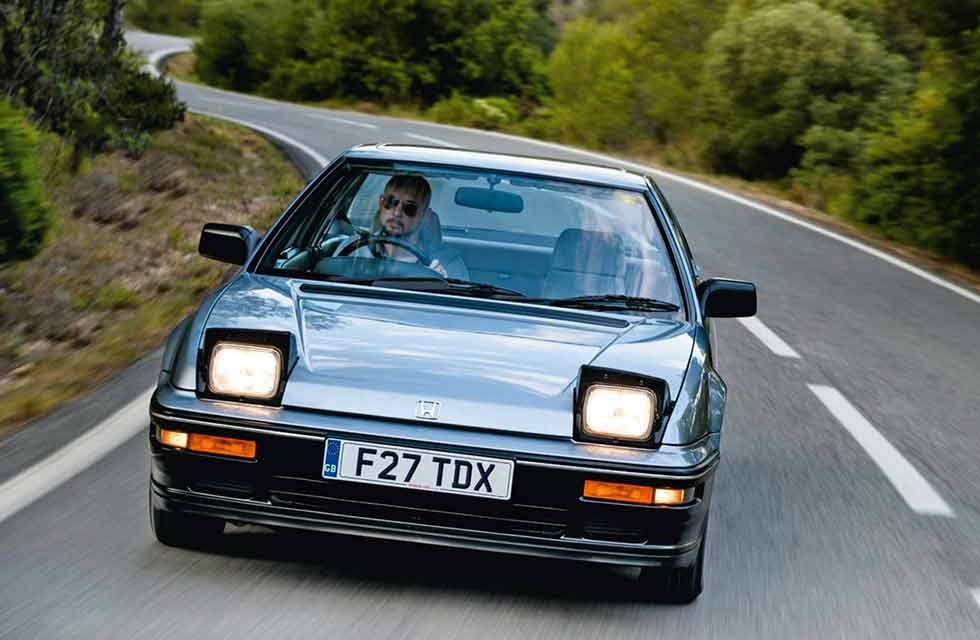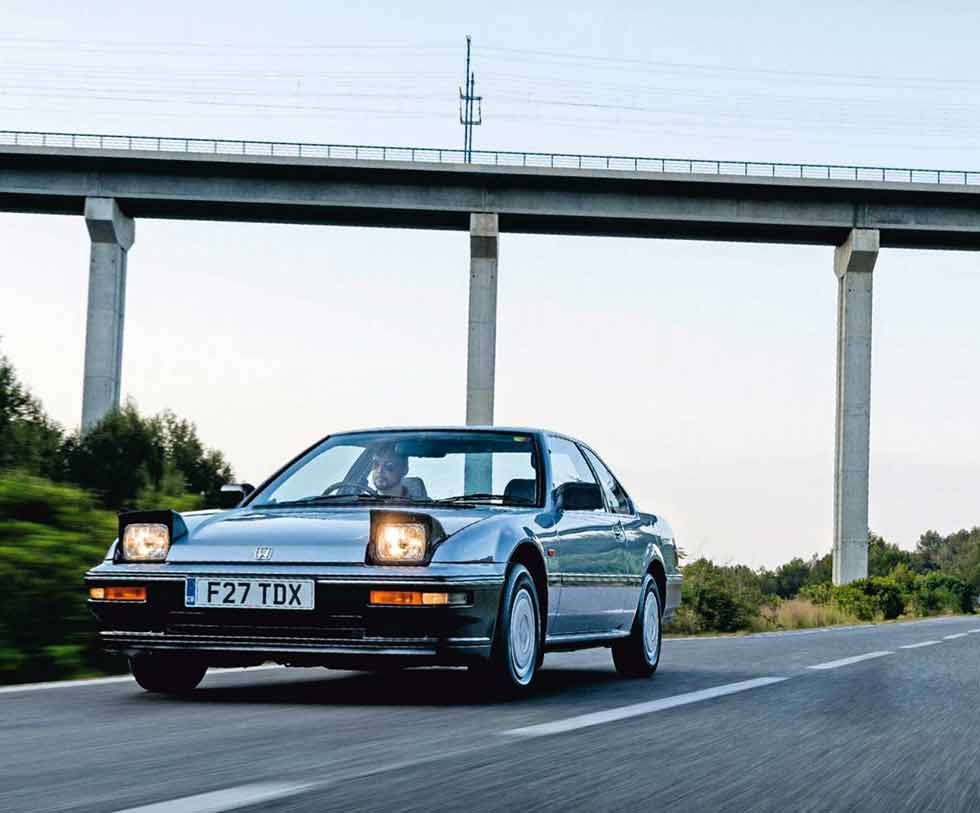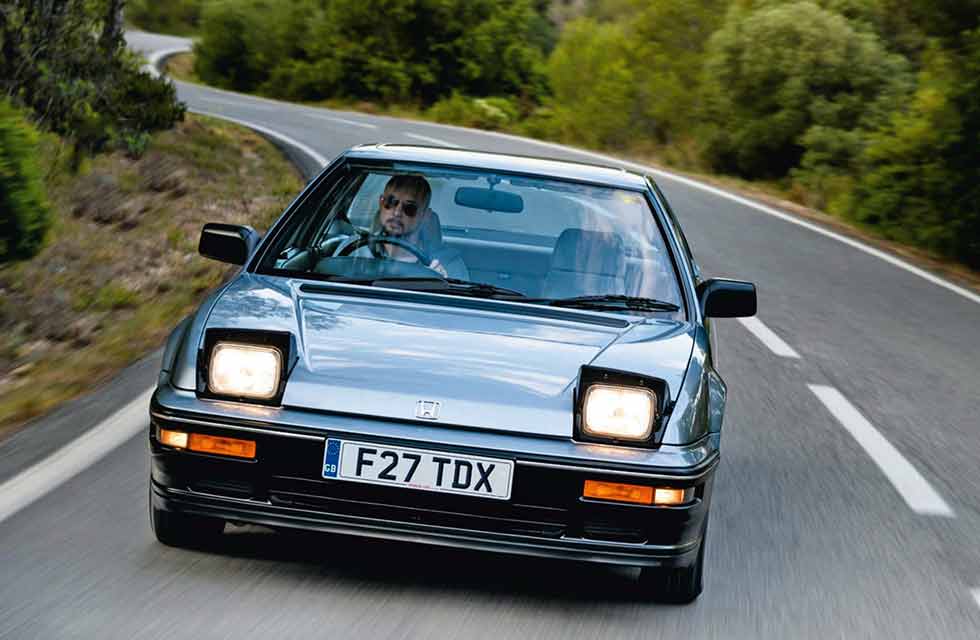
Endangered Species: Honda Prelude Honda tried to take on Europe with this Origami-styled coupe. Now the few remaining need saving… Honda’s angular Prelude put into sharp focus. Honda Relude Innovative 1980s coupé. That deserves saving. Honda’s third-generation Prelude was a technical masterpiece but sadly few were impressed enough to buy one. JJ drives it to see if we’ve missed out…Words John-Joe Vollans. Photography Dean Smith, Honda.
ENJOYING How have we all missed the BA Prelude’s charms for this long? Most were turned into bean cans years ago, we try one of the last left.
85 UK LEFT
Prelude to extinction
Before the Fast & Furious reboot and its torrent of ever more ridiculous sequels made everything four wheeled and Japanese desirable overnight, it’s unlikely that anyone apart from your grand ad would have given a fig about the first two generations of the Honda Prelude. Based on the oh-so-sensible Accord, early versions were about as exciting as an off-season trip to Cleethorpes.

However, there was to be a brighter future for the firm’s flagship coupe. The Prelude was promoted to Honda’s engineering and innovation test mule and soon after, things started to get a lot more interesting.
By the time the model bowed out in 2001 the Prelude, over all five of its generations, had been responsible for introducing Honda customers to fuel injection, active torque transfer and, most notably, four-wheel steering. The third-generation Prelude was the tipping point when the model really came into its own. Pre-NSX and even pre-VTEC, this was the generation that took up the coupe mantle that had been abandoned by the European manufacturers and took it to new heights. The sad fact is that there are only 85 third-generation (BA) Preludes remaining. Where did they all go and should we mourn their passing? It’s time to find out…

It’s hard to picture today, but in the mid-1980s the British public, and the wider motor industry, was still rather dismissive of Japanese cars, especially Japanese performance cars. We’d only come to terms with the fact the Japanese were building reliable, efficient and likeable hatches and saloons a few years prior. The thought of them muscling in on the traditional European sports coupe territory was still cause for the odd titter and guffaw. You know what they say about pride coming before a fall…
With hot hatches selling by the container-ship load, the big European makers didn’t see a future in the coupe sector and almost gave up trying. Volkswagen relied upon its previous generation Golf platform for the second generation Scirocco while Ford kept making the archaic leaf-sprung Capri and Opel soldiered on with the Ascona-based Manta. Almost every coupe still on sale by the late 1980s was a leftover from the previous decade given a nip and a tuck.
Just when it looked like the coupe market pond was drying out, Japan’s big three opened the sluice gate. Suddenly, consumers had the choice of a brand-new Nissan 200SX, Toyota Celica or Honda Prelude. European makers were caught on the back foot and would take until the early 1990s to mount an effective defence.
Honda’s third-generation Prelude arrived in 1987 and offered one of the decade’s most inventive two-door machines. It looked great, with a low and sleek bonnet line (the lowest of any front-wheel-drive coupe to date) and those essential 1980s appendages, pop-up lights.
The proportions were spot on, and there was even a cheeky kamm-tail rear to reinforce the car’s sporting appeal. Underneath the origami lines there’s a clever mechanical package. The suspension is a double wishbone affair.
The only engine you’ll find in this Prelude generation is the 12-valve B20A motor. It’s available in single camshaft, 114bhp twin carburettor tune or a fruity, fuel injected 160bhp twin-cam(pre-VTEC remember) version. Both engines are robust and tunable, with 200bhp easily achievable from a few choice cylinder head mods.
Even stock the performance is still handy, there’s less than 1100kg to move after all. The DOHC version of the B20A fitted to The Prelude 2.0Si was fuelled by Honda’s PGM-FI or programmable fuel injection system to you and me. A clever technology derived from motorbikes. The system was first seen on the 1982 Honda CX500TC turbocharged bike. This fully electronic fuel injection takes many readings per second from sensors monitoring engine speed and throttle position then references these against a stored fuel ‘map’ to assess the ideal amount of fuel to send to the cylinders. This basic fuel delivery figure was made more accurate before final delivery by additional sensors monitoring intake pressure, coolant temperature and atmospheric pressure. We haven’t even dealt with the constant mechanical four wheel steer system either (see box out left), but essentially Honda used this Prelude as an engineering showcase.
All these innovations were notable in period but sadly have been long forgotten. Today simply finding a Prelude with 4WS or twin camshafts is hard enough. So much so in fact, that Honda’s own BA Prelude (seen here), part of its heritage fleet, is a modest base model 2.0-litre EX.
That means it’s fitted with the single cam 114bhp engine and doesn’t have four-wheel steer. That’s a shame but its condition is such that it was far too good to ignore. We’re in Spain for a heritage event celebrating all of Honda’s excellent back catalogue of driver’s cars. It’s telling that out of all the fabulous Civics, Integras and S2000s, I muscle past the rest of the journos to get a first drive in the Prelude. This Prelude comes from a lost era. It’s been overshadowed by the TypeR generation. I love a hot Civic or Integra, but it’s really refreshing to get this glimpse of a fledgling Honda dipping its toe into performance motoring. The cabin gives a clue of things to come, with the wrap around dash and door cards enclosing you tightly within. There’s a fighter jet feel to it that’s reinforced further by the almost total visibility. The BA Prelude’s slim windscreen, door and rear screen pillars were specifically designed from high strength steel so that they could be as thin as possible without compromising stiffness and crash safety. The glass area is astonishing, giving the driver a near unparalleled 326 degrees of vision.
This panoramic vision comes in very handy as we pull away from the Le Meridien Hotel on the shores of the Balearic Sea. We’re in the Catalonia region of north eastern Spain in June so that glass area has another unwanted side effect, it’s acting like a greenhouse and there’s no aircon. Thankfully as I point the Prelude onto the hillside roads heading inland it gets cooler as we climb. The steering on this Prelude is a bit light but the lack of effort is welcome in this heat.
What’s not so welcome are the terrible brakes. The middle pedal has to be mashed to cause any significant change in speed. It’s probably not too surprising as the vented front and solid rear discs have to fit under 14-inch wheels. The ride, which was choppy at lower speeds around town, becomes smoother as the pace increases.
Up in the hills the Prelude proves very capable. Its 12-valve B20A4 engine might not have the punch to wow, but its accessible torque delivery and the five-speed transmission’s perfectly spaced ratios makes it very engaging. It wills me to extract every drop of performance. The chassis is competent but push too hard and you’ll push the front wide, probably more a result of the 165 cross section tyres. Lift off too vigorously and the tail will rotate slightly, tightening your line. As this Prelude has covered just 22,000 miles in its 30-year history and it looks and feels like a car a tenth of its age, we decide against pushing it any further.
The Modern Classic view
Driving this Prelude might not provide nerve-shredding adrenaline thrills, but what it offers instead is a shedload of nostalgia. Cars just don’t look like this anymore; pedestrian safety legislation has made sure of that. The acute angles formed by every panel, the simple, uncluttered analogue dials and of course those awesome pop-up lights, which incidentally work in perfect synchronisation – this is a Honda after all – give you a glimpse back to the glory days of the Japanese coupe.
Where our home-grown European alternatives felt like they belonged to your dad’s generation, the sporting products from Japan in the 1980s helped usher in a bright new, technology-filled motoring future while still offering huge driver rewards. The Prelude was on the leading edge of this new wave and yet has survived in such tiny numbers that its appeal is not merely limited to being symbolic of its era, it offers genuine exclusivity too. It’s this mix that will spark increasing enthusiast interest. A new generation who were too young to actually remember these cars when they were new is digging the Prelude. Let’s just hope enough are saved before this vital coupe vanishes forever.
TECHNICAL DATA FILE SPECIFICATIONS 1987 Honda Prelude (Gen III / Third generation BA3/4/5/7)
Engine 1958cc, 4-cyl, SOHC
Transmission FWD, 5-speed manual
Max Power 114bhp @ 5800rpm / DIN nett
Max Torque 116lb-ft @ 4500rpm / DIN nett
Weight 1095kg
PERFORMANCE
0-62mph 9.8sec
Top speed 118mph
Economy 34mpg
WHAT TO PAY
Concours £7500
Good £5500
sable £3500
Project £1500
‘LIFT OFF TOO VIGOROUSLY AND THE TAIL WILL ROTATE, SLIGHTLY TIGHTENING YOUR LINE’
‘THE GLASS AREA IS ASTONISHING GIVING THE DRIVER NEARLY 326 DEGREES OF VISION’
‘ONE OF THE MOST INVENTIVE TWO-DOOR MACHINES OF THE DECADE’
WHERE DID THEY ALL GO?
A Japanese car from the 1980s… we’ll give you one guess what finished off the majority of BA Preludes. Yes, that’s right, they rotted away quicker than an iffy banana in a warm fruit bowl.
Aside from the usual ravages of corrosion, however, it seems many a BA Prelude was also scrapped due to either its mechanical complexity or an unfounded fear of the same. Admittedly, the cost of repairing that innovative four-wheel steer system can mount up, but the main problem is that the parts needed to fix them have been in short supply for decades.
Combine this with the long period of enthusiast apathy for this era of Honda and it’s little wonder that most cars that developed issues were either laid up or scrapped years ago. This certainly accounts for the higher than normal ratio of cars residing on SORN versus those still on the road. It’s always a shame when any overlooked old car finds itself in terminal decline, but in the case of the Prelude it’s even more painful as it’s such a useable classic. If you find one of the few survivors, bring it up to scratch and drive it every day… you won’t regret it.
‘ONE OF THE MOST INVENTIVE TWO-DOOR MACHINES OF THE DECADE’
Very much a Driver focused car. A few mods could unleash 200bhp.
Prelude dances through Spanish mountains. Thinner pillars means more glass, and a better view. Prelude was the shape of things to come. Wraparound dash encloses the driver. Where Home mixed C90s go.
Simple and analogue, how we like it. Prelude’s pop-ups work perfectly.
‘THE GLASS AREA IS ASTONISHING GIVING THE DRIVER NEARLY 326 DEGREES OF VISION’
‘LIFT OFF TOO VIGOROUSLY AND THE TAIL WILL ROTATE, SLIGHTLY TIGHTENING YOUR LINE’
I BOUGHT ONE DAVID GREEN
‘One of my top five drives was in 1990 in the Borders with a 4WSBA Prelude. On the A7 it really came into its own. When a one-owner 36,000-mile example came up for sale a couple of years ago, I had to have it. The thing that struck me most upon re-acquaintance with the Prelude was its extraordinary all-round visibility. I’ve since added about 3000 miles and haven’t had to spend a penny on it, not even much on fuel (it returns over 38mpg on motorway).’
FOUR-WHEEL STEERING
Honda didn’t come up with the idea of four-wheel steering (4WS) – it had been around since the 1930s. However, it was the first major manufacturer to deploy the technology for a mainstream production model.
Honda’s system is an entirely mechanical one. The front and rear wheels are in constant contact. A glance underneath reveals what looks like a scaled-down four-wheel drive system. There’s a driveshaft that comes from the back of the steering at the front, engaging with a gearbox at the rear. Steering input is then translated via planetary and hypocyloid gears to a pair of tie rods. These adjust the rear wheel toe in or toe out depending on steering input.
Turn the wheel less than 246 degrees and the rear wheels will turn up to 1.5 degrees in the same direction as the fronts. This is designed to improve handling at higher speeds and aids lane changes on the motorway.
Over 246 degrees of steering will cause the rear wheels to turn up to 5.3 degrees in the opposite direction to the fronts, tightening the car’s turning circle by ten per cent, allowing the 4WS Prelude to turn in an impressive 33ft. In handling terms, this allows for much tighter cornering in hairpins and easier negotiation of carparks.
However, don’t expect it to do you any favours when parallel parking. Approach the kerb and turn tightly to pull alongside and the Prelude will shunt its rear into the kerb… less than helpful and it takes a little getting used to.
Reception to 4WS can best be described as lukewarm. Handling and steering effects were modest with many testers hardly able to tell the difference. It was a similar story with customers who had expected more for their relatively expensive investment over the stock models.
The second generation 4WS Prelude ditched the all-mechanical system for a computer controlled electric motor.
This overcame some of the mechanical system’s limitations, namely its inability to react quickly and its relative cost and complexity. It still wasn’t a big hit in Europe and North America but in its domestic, tech-obsessed market, customers loved it. Several patents were filed in a very short time in the late- 1980s with systems from Nissan and Toyota rapidly appearing. The tight streets of Japan’s cities seemed to be the only place where 4-wheel steering really made any sense. Eventually, even Japanese customers fell out of love with it and it wasn’t replaced after the end of Prelude and R34 production in 2001 and 2002 respectively.
Four-wheel steer, like Paula Abdul, was popular in the late 1980s.






